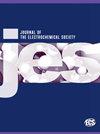PVDF Binder in All-Solid-State Lithium Batteries with NCM/Sulfide/PVDF Cathode, Oxide/PEO SE Layer, and Li-metal Anode
IF 3.3
4区 工程技术
Q2 ELECTROCHEMISTRY
引用次数: 0
Abstract
Sulfide-based solid electrolyte such as Li6PS5Cl (LPSCl) is unstable in contact with Li metal electrode due to decomposing to by-product resulting in poor performance. Therefore, the introduction of an interlayer to suppress reactivity is essential. In this study, instead of an interlayer, an oxide/polymer composite electrolyte was applied to suppress side reactions, while a sulfide-based electrolyte was used at the cathode to improve interfacial control between the cathode and the electrolyte. All-solid-state lithium batteries (ASLBs) were prepared by applying sulfide-based solid electrolyte (argyrodite, Li6PS5Cl) including NCM424, polyvinylidene fluoride (PVDF), and Super-P in a composite cathode layer, and a composite solid electrolyte (CSE) layer by mixing an oxide-based solid electrolyte (garnet, Al-doped Li7La3Zr2O12 (LLZO)), polymer (PEO, polyethylene oxide) and lithium metal as the anode. In this study, NCM424 powder was coated with LiNbO3 to prevent chemical reaction with the sulfide electrolyte. As the PVDF binder was applied to the cathode of the ASLB, the discharge capacity of the cell was approximately 163 mAh g−1 at 70 °C, 0.1 C, and 4.2 V cut-off and its capacity retention was 83% after 50 cycles. The effects of the PVDF were evaluated using both pouch-type cells. The capacity and cycle retention are greatly dependent on the PVDF content of the cathode materials and the drying temperature during the fabrication of the cathode. When the cathode with PVDF binder was dried at 130 °C, initial cycling was required for activation of the pouch cell, and it was possible to overcome this by adding a plasticizer. Highlights The composite cathode was prepared with LPSCl, NCM424, Super-P, and PVDF binder. The all-solid-state battery with the LPSCl composite cathode showed a discharge capacity of 163 mAh g−1 at 0.1 C. The cycling performance of the battery was improved by improving the properties of the active material particles.带有 NCM/Sulfide/PVDF 阴极、氧化物/PEO SE 层和锂金属阳极的全固态锂电池中的 PVDF 粘合剂
硫化物固体电解质(如 Li6PS5Cl (LPSCl))与锂金属电极接触时会分解成副产品,从而导致性能不稳定。因此,必须引入中间膜来抑制反应性。在这项研究中,采用氧化物/聚合物复合电解质代替中间层来抑制副反应,同时在阴极使用硫化物电解质来改善阴极与电解质之间的界面控制。通过在复合阴极层中使用包括 NCM424、聚偏二氟乙烯(PVDF)和 Super-P 在内的硫化物基固体电解质(霰石,Li6PS5Cl),制备了全固态锂电池(ASLB)、以及将氧化物基固体电解质(石榴石、掺铝的 Li7La3Zr2O12 (LLZO))、聚合物(PEO,聚氧化乙烯)和金属锂混合作为阳极的复合固体电解质(CSE)层。在本研究中,NCM424 粉末表面涂有 LiNbO3,以防止与硫化物电解质发生化学反应。将 PVDF 粘合剂应用于 ASLB 的阴极时,在 70 °C、0.1 C 和 4.2 V 截断电压条件下,电池的放电容量约为 163 mAh g-1,循环 50 次后容量保持率为 83%。我们使用两种袋式电池对 PVDF 的效果进行了评估。容量和循环保持率在很大程度上取决于阴极材料中的 PVDF 含量和阴极制造过程中的干燥温度。当含有 PVDF 粘合剂的阴极在 130 °C 下干燥时,需要进行初始循环才能激活袋式电池,而通过添加增塑剂可以克服这一问题。亮点 使用 LPSCl、NCM424、Super-P 和 PVDF 粘合剂制备了复合阴极。使用 LPSCl 复合阴极的全固态电池在 0.1 C 时的放电容量为 163 mAh g-1。
本文章由计算机程序翻译,如有差异,请以英文原文为准。
求助全文
约1分钟内获得全文
求助全文
来源期刊
CiteScore
7.20
自引率
12.80%
发文量
1369
审稿时长
1.5 months
期刊介绍:
The Journal of The Electrochemical Society (JES) is the leader in the field of solid-state and electrochemical science and technology. This peer-reviewed journal publishes an average of 450 pages of 70 articles each month. Articles are posted online, with a monthly paper edition following electronic publication. The ECS membership benefits package includes access to the electronic edition of this journal.

 求助内容:
求助内容: 应助结果提醒方式:
应助结果提醒方式:


